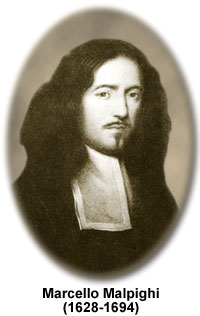Marcello Malpighi
(1628-1694)

Marcello Malpighi was a seventeenth century Italian physiologist who directed his microscope toward biological investigations and became one of the greatest microscopists of all time. Many historians regard Malpighi as the father of microscopical anatomy in both animals and plants, although he was considered more of a practical researcher than a theorist. Malpighi was born in Cavalcuore, Italy, near Bologna as the son of an estate owner who became embroiled in a bitter dispute with his neighbors that lasted most of Malpighi's life.
Malpighi studied Aristotelian philosophy at the University of Bologna while he was very young and graduated as a medical doctor at the age of 25. For most of his career, Malpighi combined an intense interest in scientific research with a fond love of teaching. He was invited to correspond with the Royal Society in 1667 by Henry Oldenburg, and became a fellow of the society the next year.
Most of Malpighi's research was published in the form of journal articles to the Royal Society, an unusual practice for the period, but very common among scientists today. His first publication in 1661 announced his observations on the anatomy of the frog lung. While observing dissected lung tissue, Malpighi discovered a network of tiny thin-walled microtubules, which he named capillaries. He went on to hypothesize that capillaries were the connection between arteries and veins that allowed blood to flow back to the heart.
Malpighi turned his attention to a variety of other animals and in 1669, published the results of his work on the silkworm. He discovered that these insects had no lungs, but breathed through a row of holes located on the side of their long bodies. Distribution of the air within the insect occurs through a system of tubules that Malpighi termed trachea. His later studies on plants led him to erroneously believe that tiny tubes found in many plants performed the same function as did trachea in insects. Based on this conclusion, Malpighi hypothesized that plants and animals had similar breathing mechanisms.
Malpighi also conducted a number of studies on chick embryo development and made major contributions to the science of embryology. He produced a series of drawings of the embryo as it developed, a revolutionary piece of work at the time. He also discovered papillae (taste buds) while examining human tongues, and recognized that the liver had a glandular nature. Malpighi was the first to attempt a thorough study of the fine anatomical details of the brain. Although most of his theories of brain function were incorrect, he did decipher some of the distribution of gray matter in the brain.
Malpighi's strong interest in the anatomy of plants was a deviation from the mainstream of research during the 1600s, when most scientists studied humans and other animals. His work encouraged other scientists to explore the cells and tissues of plants, and this is primarily the reason he is noted as a great scientist of plant anatomy. After ten years of study, he submitted a paper about his plant work to the Royal Society that summarized his observations. It was published as a book entitled Anatomia Plantarum (Plant Anatomy), which was an exhaustive comparative study of plants containing many excellent drawings. Among Malpighi's many contribution to plant anatomy was the discovery of stomata, the pores of leaves.
